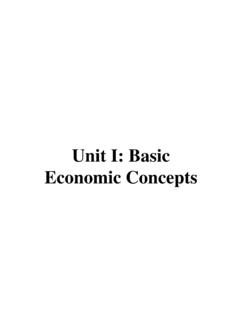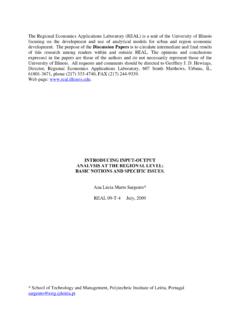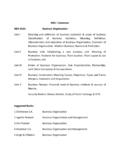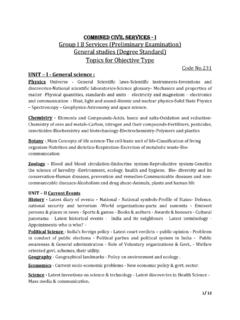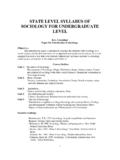Transcription of Basic Concepts In Project Appraisal - AGSM
1 Week 2 A G S M 2006 Page 1. Basic Concepts In Project Appraisal [C&B Ch. 2, 3; DoF Ch. 4; FP Ch. 3, 4, 5]. 1. Which Investment Criterion? 2. Investment Decision Criteria 3. Net Present Value Annual User Charge / Value On Completion /. Annual Value / Annuities 4. Internal Rate of Return 5. B/C Ratio 6. Payback Period 7. Inflation 8. Income Tax 9. Discount Rates for Public- and Private-Sector Projects. 10. Consistency of Horizon/Residual Value 11. Capital Rationing >. Week 2 A G S M 2006 Page 2. 1. Which Investment Criterion? [L ]. Net Present Value: T b(t ) c(t ). NPV = K, t =0 (1 + r ). t whereNPV = net present value from Project b(t ) = benefits ($) received from Project in year t c(t ) = costs ($) of Project in year t 1.
2 = discount factor at interest rate r 1 + r (t ). T = lifetime of Project K = initial (capital) outlay at t = 0. < >. Week 2 A G S M 2006 Page 3. Questions: (These issues will take several lectures.). 1. Which benefits b and costs c to include? 2. How are they to be valued? ( shadow prices?). 3. At which rate(s) r to discount? 4. Which investment criterion to use? < >. Week 2 A G S M 2006 Page 4. 2. Investment Decision Criteria [C&B 53; DoF Ch. 4, App. III; FP Ch. 5]. 3. Net Present Value (NPV). Annual User Charge. Value on Completion. Annuity Values. 4. Internal Rate of Return (IRR). 5. Benefit/Cost Ratio (B/C).
3 6. Payback Period. < >. Week 2 A G S M 2006 Page 5. Opportunity Cost again .. The basis for decisons must be opportunity cost, or the value of options forgone. Neither IRR nor B/C can be adequately used to choose between two mutually exclusive projects. In general, we want to compare two (or more). projects and choose one (mutually exclusive). < >. Week 2 A G S M 2006 Page 6. Consider two projects, A and B. Each costs $100 in year 0. Project A returns nothing in year 1, and $121 in final year 2. Project B returns $115. in final year 1, and nothing thereafter. Year 0 Year 1 Year 2. Project A $100 0 $121. Project B $100 $115 0.
4 At a zero discount rate, Project A is more attractive. Why? At a discount rate of pa the two projects are equally attractive (and have a positive NPV). At a discount rate of 10% pa Project A has an NPV of zero: its IRR is 10% pa. Why? At a discount rate of 10% pa Project B has a positive NPV. At a discount rate of 15% pa Project B has an NPV of zero: its IRR is 15% pa. Why? At a discount rate of 15% pa Project A has a negative NPV. < >. Week 2 A G S M 2006 Page 7. So, choose Project A if the market rate is less than , or Project B otherwise, if the criterion is maximizing the NPV. Choose Project B if the criterion is maximizing IRR.
5 20. 10. NPV 0. NPV B. 10 NPV A. 0 5 10 15. Discount rate r %. Find r 1 where two projects have equal NPV by solving for r 1 : NPV A (r 1 ) = NPV B (r 1 ): r 1 = 115 121. where NPV B = 100 + and NPV A = 100 +. 1+r (1 + r )2. < >. Week 2 A G S M 2006 Page 8. 3. Net Present Value [C&B 43; DoF Ch. 4; L. ; FP Ch. ]. Calculate NPV (or NPB) of each Project using r m (the appropriate market rate or rates they may vary through time of return) (Using the formula on Lecture 3-2, above.). > 0 then the Project is OK. if NPV = 0 indifferent < 0 then the Project is not OK, because the return ( the appropriate market rate ).
6 Is higher than the return from this Project . The opportunity value is negative. < >. Week 2 A G S M 2006 Page 9. Many projects? If there are many projects, mutually exclusive, and there is no budget constraint, then rank by positive NPV > 0. and go with the largest NPV, since this Project maximises the size of the return. Yes, if only 1 chosen. No, if can choose several. < >. Week 2 A G S M 2006 Page 10. Three types of decision: 1. accept or reject: accept if NPV > 0. reject if NPV < 0. 2. ranking . a. If no capital budgeting, (or other rationing), then accept all projects with NPV > 0. b. If there is capital budgeting, (See 11.)
7 Below). then rank: by B/C, not by NPV. < >. Week 2 A G S M 2006 Page 11. Annual User Charge (AUC). Concepts : Opportunity Cost: The opportunity cost of a Project is what is forgone by undertaking the Project the value of resources in next-best use. Depreciation (economic): The change (fall) in market value of an asset. Implicit rental cost: The opportunity cost of holding (owning) an asset. ( a machine). = the implicit rental cost = the sum of: the interest forgone on outlay +. depreciation +. any operating costs. (Don't use straight-line depreciation: use annuity.). < >. Week 2 A G S M 2006 Page 12. Example of Annual User Charge (AUC): Purchase of vehicle.
8 Bought for $2. Sold at $1 one year later. i = 10% ; costs $ to run for one year Interest charge = $2 = $ Depreciation charge = $2 $1 = $ Operating cost = $ AUC = $ Marginal cost: How much more does it cost to produce an extra unit of output? Average cost: What does it cost per unit of output? < >. Week 2 A G S M 2006 Page 13. Value On Completion A Project involves: cash investment outlays = x t without receipts over the first T years of the Project , followed by net operating revenues x t over the operating life of the Project represented by L (t from T + 1 to T + L). The NPV of the Project can be assessed as: x1 x2 xT.
9 NPV 0 = x 0 .. 1 + r (1 + r ) 2 (1 + r )T. xT +1 xT +L. + + .. +. (1 + r )T +1 (1 + r )T +L. < >. Week 2 A G S M 2006 Page 14. VOC Criterion. An equivalent but simpler method is to compute the Value On Completion (VOC): VOCT = x 0 (1 + r )T + x 1 (1 + r )T 1 + .. + xT. That is: accumulate forward your investment outlays at the cost of capital, to the last date (T ) at which the completed Project costs. Then: Compare VOCT with NPVT , where both evaluations refer to the same date. So we compute: xT +1 xT +2 xT +L. NPVT = + + .. +. 1 + r (1 + r )2 (1 + r )L. < >. Week 2 A G S M 2006 Page 15. VOC Criterion: Note: NPVT VOCT.
10 NPV 0 = > 0 if NPVT > VOCT. (1 + r )T. Accept the Project if the VOC is less than or equal to the NPV of cash flows over the operating life of the Project . Moreover, VOC = Direct Capital Outlays + Interest During Construction < >. Week 2 A G S M 2006 Page 16. Example 1 of VOC: $1 is outlaid at the beginning of each of 3 periods (T = 2). The asset operates for two years, yielding a net revenue stream of a (L = 2). The discount rate r = 10% Diagrammatically: VOC 2 NPV 2. a a T=0 T=1 T=2. T=3 T=4. 1 1 1. < >. Week 2 A G S M 2006 Page 17. Calculating various values, forwards and back .. 1 1 a a NPV 0 = 1 2. + 3.

